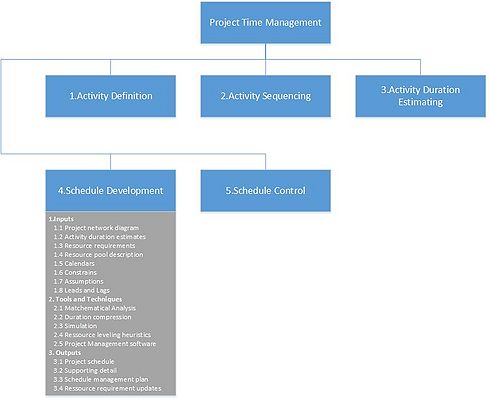Project Schedule development
(→Project Time Management) |
(→Project Time Management) |
||
| Line 11: | Line 11: | ||
As it is shown in Figure 1. according to PMBOK, The Time Project Management consists of : | As it is shown in Figure 1. according to PMBOK, The Time Project Management consists of : | ||
| − | * Active Definition | + | * Active Definition- defining particular tasks necessary to accomplished project's goals. |
| − | * Activity Sequencing | + | * Activity Sequencing- defining dependencies between project's tasks. |
| − | * Activity Duration Estimating | + | * Activity Duration Estimating- estimating the number of work periods that will be needed to execute individual task. |
| − | * Schedule Development | + | * Schedule Development- evaluating the sequences of the tasks, its duration and resources requirements in order to prepare the project schedule. |
| − | * Schedule Control | + | * Schedule Control- monitoring variations to the project schedule. |
(different sources: PMI<ref>https://www.pmi.org/learning/library/time-management-project-functions-schedules-5283. Retrieved 11 February 2018</ref> divides it into 4 areas: Time Planning, Time Estimating, Time Scheduling and Time Control). | (different sources: PMI<ref>https://www.pmi.org/learning/library/time-management-project-functions-schedules-5283. Retrieved 11 February 2018</ref> divides it into 4 areas: Time Planning, Time Estimating, Time Scheduling and Time Control). | ||
| + | |||
| + | The overview is meant to be standardized for general purpose of the all project, however based on close connection between Activity Sequencing,Duration Estimating and Development, they may be treated as one process, especially in small projects.<ref>Page 60, 1996 ed. PMBOK® Guide.</ref>. | ||
===Schedule Development=== | ===Schedule Development=== | ||
Revision as of 20:16, 18 February 2018
Contents |
Abstract
Soon. Stay tuned.
Motivation
There are many reasons behind Project Schedule development to be taken with appropriate caution, while planning time frame of the project. First of all, it provides in structure way the scheme and toolkit for planned activities. Following the guidelines, it allows to build sufficiently detailed plan of actions with the time frame for each activity, enable tracking the progress and updating the schedule if necessary. Secondly, implemented correctly decrease the risk of delays, helps allocated resources, which may results in minimizing potential costs of the project.
Introduction
Project Time Management
Project Time Management is defined as set of processes with outputs to ensure all the activities throughout the project are accomplished on time.[1].. It is about increasing both efficiency and effectiveness and to control over the time spent on the particular tasks. As one of the key Project Management areas, the process plays a major role in each out of five project phases. It reflects to the overall performance during the project life cycle as well as the individual task consumption.“Control of time is competitive advantage”[2], wisely used can increase benefits and decrease the costs of a project.

As it is shown in Figure 1. according to PMBOK, The Time Project Management consists of :
- Active Definition- defining particular tasks necessary to accomplished project's goals.
- Activity Sequencing- defining dependencies between project's tasks.
- Activity Duration Estimating- estimating the number of work periods that will be needed to execute individual task.
- Schedule Development- evaluating the sequences of the tasks, its duration and resources requirements in order to prepare the project schedule.
- Schedule Control- monitoring variations to the project schedule.
(different sources: PMI[4] divides it into 4 areas: Time Planning, Time Estimating, Time Scheduling and Time Control).
The overview is meant to be standardized for general purpose of the all project, however based on close connection between Activity Sequencing,Duration Estimating and Development, they may be treated as one process, especially in small projects.[5].
Schedule Development
Tools & Implementation
Limitation of PSD
Output of PSD
Glossary
References
- ↑ Page 59, 1996 ed. PMBOK® Guide.
- ↑ https://www.pmi.org/learning/featured-topics/time. Retrieved 11 February 2018
- ↑ Page 60, 1996 ed. PMBOK® Guide.
- ↑ https://www.pmi.org/learning/library/time-management-project-functions-schedules-5283. Retrieved 11 February 2018
- ↑ Page 60, 1996 ed. PMBOK® Guide.